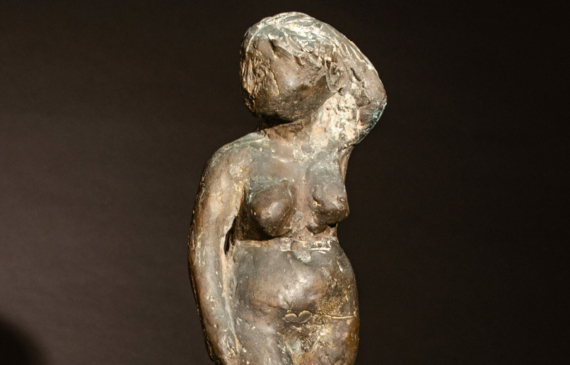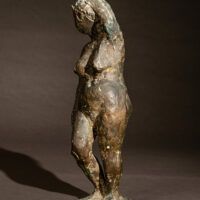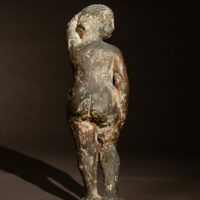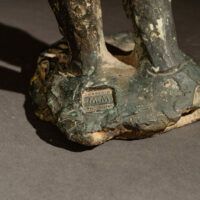Marino Marini





Marino Marini
Italian, 1901-1980
Piccola Pomona
Bronze
16 H. x 5 W. x 4 D. inches
Stamped on base: Fonderia M.A.F. Milano
Artist Description
Italian sculptor Marino Marini was born in 1901 in Tuscany. After studying at the Accademia di Belle Arti in Florence in 1917, he dedicated himself primarily to sculpture beginning in 1922. He was influenced by Etruscan art and the sculptures of Arturo Martini, who he succeeded as professor at the Scuola d’Arte di Villa Reale from 1929 to 1940.
Marini often visited Paris during this period and spent time with painters such as Massimo Campigli, Giorgio de Chirico, Alberto Magnelli, and Filippo Tibertelli de Pisis. After moving to Tenero-Locarno, Switzerland, in 1936, he frequented Zürich and Basel and befriended the sculptors Alberto Giacometti, Germaine Richier, and Fritz Wotruba. That same year, Marini was awarded the Prize of the Quadriennale of Rome.
In 1940, Marini became a professor in sculpture at the Albertini Academy in Turin and later the Accademia di Belle Arti di Brera in Milan, training notable sculptors such as Parviz Tanavoli and Filippo Chissotti. In 1943, he exhibited in Basel, Bern, and Zurich, Switzerland, before settling permanently in Milan in 1946.
Marini was featured in the ‘Twentieth-Century Italian Art’ show at the Museum of Modern Art in 1944. The Buchholz Gallery in New York began exhibiting his work in 1950, giving Marini the opportunity to meet New York artists such as Jean Arp, Max Backmann, Alexander Calder, Lyonel Feininger, and Jacques Lipchitz. Upon his return to Europe, the Hanover Gallery in London mounted a solo show of his work, where he met Henry Moore. A Marini exhibition traveled across Germany in 1951. He won the Grand Prize for Sculpture at the Venice Biennale the next year, and the Feltrinelli Prize at the Accademia dei Lincei in Rome in 1954. He had a monumental sculpture installed in The Hague in 1959.
Marini’s work tended to focus around themes such as equestrians, nudes, portraits, and the circus. Influenced by Northern European and Etruscan sculpture traditions, he strove to interpret these classical themes through a modern lens, giving his pieces a mythological sensibility. Marini was particularly interested in the image of horse and rider, which he first sculpted in 1936. His portrayals of this pair evolved greatly throughout his career, beginning as stoic, poised figures, becoming an angry interaction with the horse rearing its head, then an image of defeat post-World War II with the horse planted firmly or with its head resting on the ground. He is most well-known for “Miracolo”, his series of abstracted equestrian statues portraying a rider falling from his horse.
Retrospectives of Marini’s work took place at the Kunsthaus Zürich in 1962 and at the Palazzo Venezia in Rome in 1966. A permanent installation of his work opened at the Galleria d’Arte Moderna in Milan in 1973. There is a museum dedicated to his work in Florence in the former church of San Pancrazio. His work may also be found in museums such as the Civic Gallery of Modern Art in Milan, the Tate Collection, The Angel of the City at the Peggy Guggenheim Collection, Venice, the Norton Simon Museum, Museum de Fundatie and the Hirshhorn Museum and Sculpture Garden in Washington, D.C.

